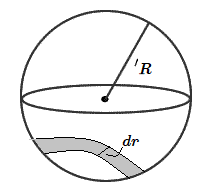Let there be spherically symmetric charge distribution with charge density P(x)=Pₒ[(5/4)-(r/R)] up-to r=R, P(r)=0 for r≻R. Where 'r'is the distance from origin. What is the electric field at a distance 'r' (r≻R) form the origin?
2 Answers
Explanation:
volume charge density,
consider a sphere of radius R

let a thin strip of radius
the surface area of the strip is
so, the small volume of the strip is
now
substitute for
now integrate to find out total charge enclosed till any point 'r'
now electric field at ny point at a distance r is given by
Explanation:
#rho(r) = {( rhoₒ(5/4-r/R), 0 le r le R),(0, r gt R):}#
Gauss' Law states that:
-
The total of the electric flux
#Phi# out of a closed surface is equal to the total charge enclosed divided by the permittivity: -
#Phi = Q_("enc")/varepsilon_o#
If we draw a Gaussian sphere enclosing, and with the same origin as, this spherically symmetric charge distribution, then:
-
The total of the electric flux out of the Gaussian sphere is equal to E-field at the surface times the surface's area:
-
#Phi = E(r) * 4 pi r^2# .
IOW, for a Gaussian sphere , concentric with the charge distribution, and of radius
#E(r) = Q_("enc")/(4 pi varepsilon_o r^2)# (Coulomb's Law with the distribution treated as a point charge)
(1) Find
For a sphere:
#V = 4/3 pi r^3, qquad dV = 4 pi r^2 dr#
(2) Find


